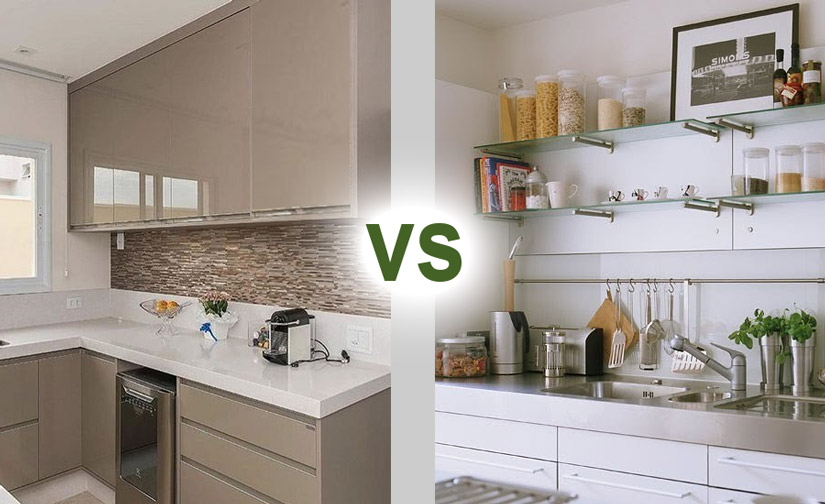
Are you one of the many homeowners considering a kitchen remodel in 2022? At one point, cabinets were the norm, so much so that a renovator may not have even considered an alternative. More recently, open shelves became a popular kitchen trend. While there is some dispute about the longevity of this style, open shelving has long been used in American kitchens, as Apartment Therapy’s Nancy Mitchell points out in her piece, “The Surprising History of a “New” Trend that isn’t New at All.” Understandably, you will find passionate designers and homeowners on both sides of the kitchen cabinets vs. open shelves debate. All of which to say, the choice is ultimately about YOU – how you use your kitchen, how you decorate, how you clean, and so forth. We’ll explore the pros and cons of each product as well as ways to combine the benefits of both.
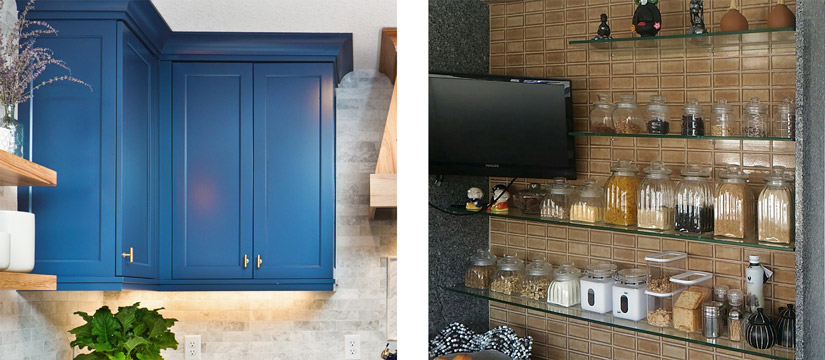
The matching built-in cabinets we’re used to today were not always the norm. A perusal of old kitchen drawings and photos highlights the fact that open shelves and furniture style cabinets were utilized simultaneously within one kitchen. As Mike Jackson points out in “The Rise of the Modern Kitchen,” early kitchen cupboards were small free-standing units. It was in the 1920s that uniform, modular cabinetry was introduced and steadily grew in popularity.
What has given this approach such staying power that it remains the go-to for many designers?

As with every design option, there are trade-offs when you go the route of modular kitchen cabinets. Picking the right product for your home is all about finding the benefits that mean the most to you and the downsides you can live with. Let’s look at some of the reasons a homeowner might explore other options than a traditional set of kitchen cupboards..
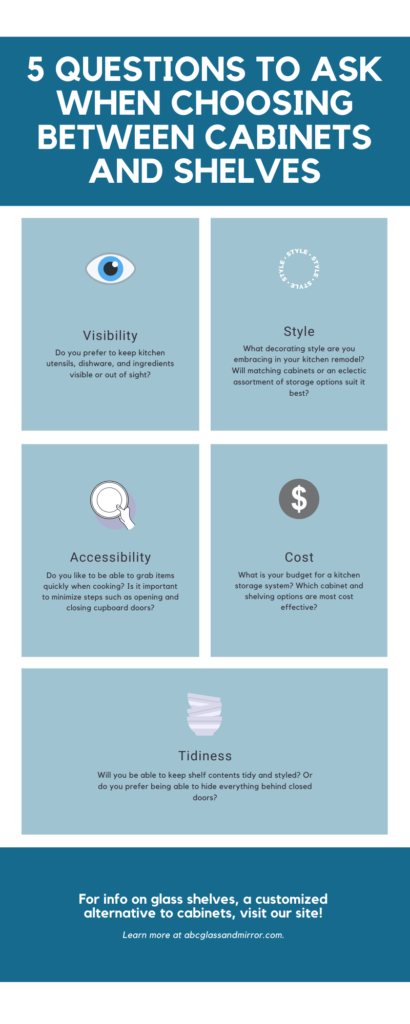
Open shelving appeals to people because it keeps everything visible and accessible AND because items tastefully arranged on shelves give the kitchen more character than rows of matching cupboard doors. For example, with open shelves, you won’t search multiple cupboards for a single item, and you can always skip the step of opening and shutting a door when you need a dish or ingredient. If you’ve been drooling over cute kitchen photos that showcase shelves lined with adorable stacks of bowls interspersed with quaint pitchers and vases of flowers, you might be anxious to try this look in your own space.
HGTV’s Erica Reitman lays out “8 Reasons You Should Try Open Shelving in Your Kitchen,” and these include:
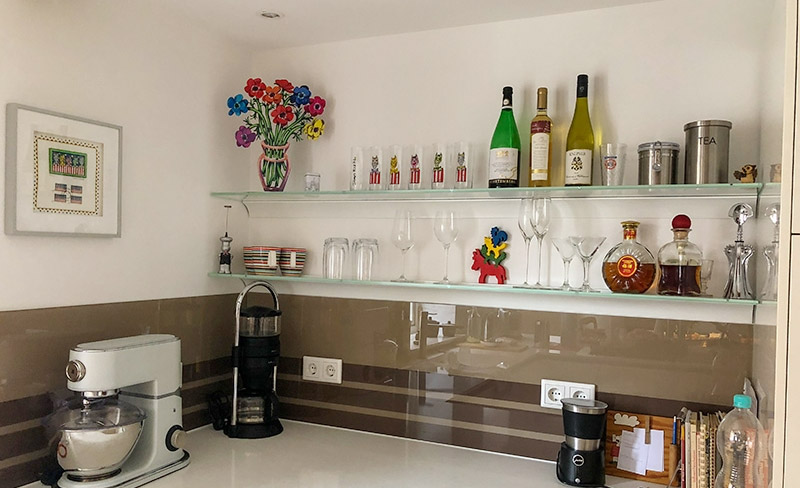
Kitchen wall shelves are typically made from:
In her post, “5 Types of Open Kitchen Shelving: Which One Fits Your Kitchen?” Brooke of Plank & Pillow highlights a few types of wooden and glass shelves. For example, floating wooden shelves combine a more rustic material with a modern installation method. Likewise, metal systems can hang from the ceiling and suspend wood or glass shelves for a beautiful combination of materials. She introduces a specific application of glass shelving in which it is installed in front of the kitchen window for a radiant blend of glass and sunlight with the items on the shelves seeming to float in midair.
Glass is an appealing material for kitchen applications because it isn’t susceptible to moisture damage and won’t be stained by spills. Glass shelves can be customized by a shop such as ABC Glass & Mirror. Homeowners value the shelves’ ability to combine style and storage, a feature that makes them appealing for outfitting a kitchen. The dimensions, placement, hanging/support system, and glass style are up to you. Clear glass is a popular choice that matches all décor and gives the kitchen a sense of spaciousness. Its smooth exterior also simplifies dusting and sanitizing. However, several other glass styles are offered if you want a somewhat different look.
Moving on to metal options, we have wire shelving and stainless steel shelves. If you’re looking to outfit your kitchen in the most budget-friendly way, wire shelves are a very appealing option. The lower price tag is a plus, but most would not consider the shelves themselves to be as attractive as wood or glass alternatives. However, this can be mitigated by using warmer materials elsewhere in the kitchen and by thoughtfully styling the items on the shelves. Solid stainless steel shelves also evoke commercial kitchens. However, they are more sleek than wire shelves and can create a very clean, futuristic vibe.
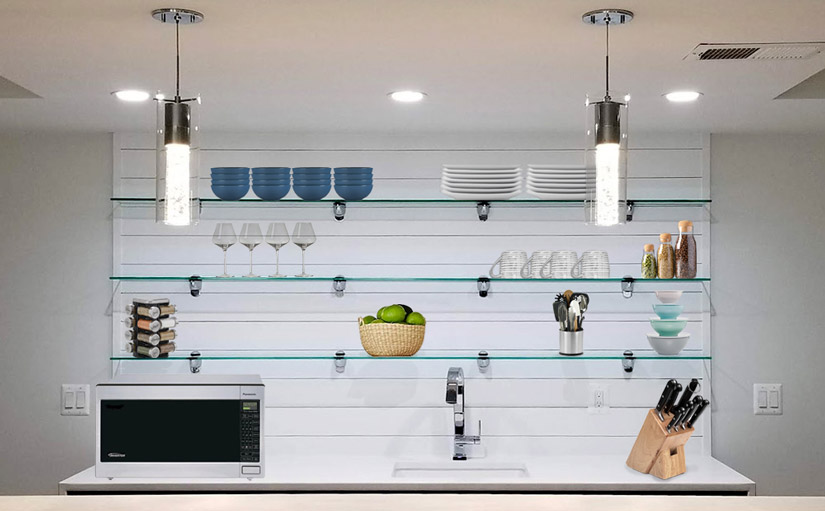
Like cabinetry, wall shelves have a lot going for them, but there are trade-offs to consider with this product, too. Common concerns about replacing cupboards with open shelves include:
If this list has dampened your excitement about the design possibilities offered by wall shelves, keep reading for ways to work around these issues.
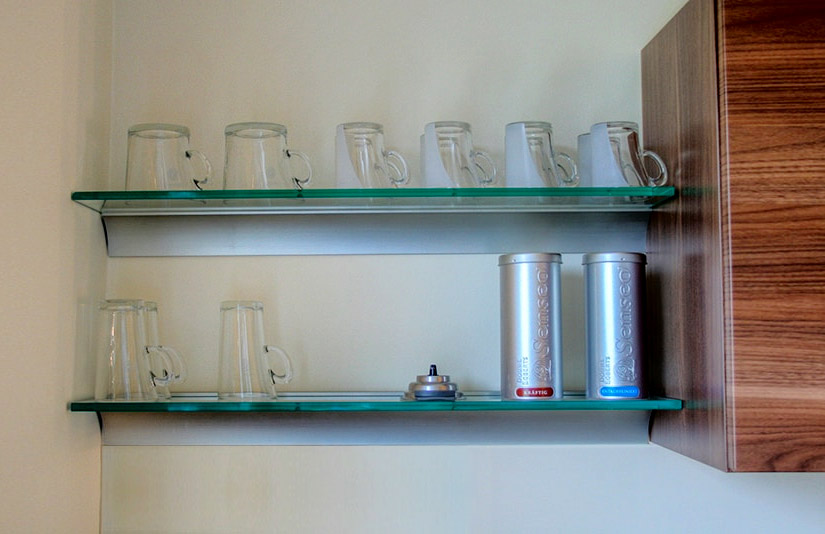
For homeowners who love the charm and convenience of open shelving but fear the practical drawbacks, a combination of cabinets and wall shelves can be the perfect solution. In fact, it is rare to totally eschew kitchen cabinets. Even hardcore open shelving aficianados tend to keep the lower cabinets while replacing the upper ones with shelves. Why? For one thing, families with little ones want to keep some kitchen items behind child-locked cupboard doors. Also, it’s true that your kitchen will look cuter with some things out of sight. After all, does anyone really want to create a vignette that includes boxes of sandwich bags and rolls of aluminum foil?
Here are some tips for successfully using both cabinets and open shelves in one kitchen.
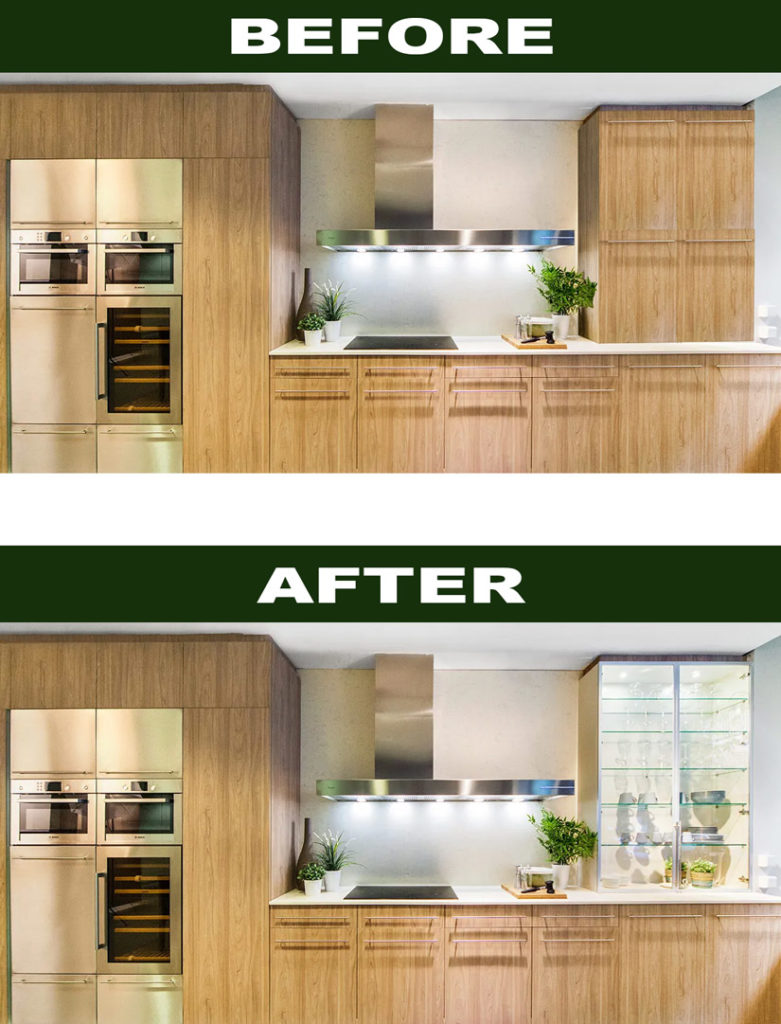
It’s true that tearing out ANY kitchen cabinets can be daunting. After all, these aren’t cheap items…not to mention the fact that you’ll need to fill holes and sand and paint the walls where the cabinets were removed. Let’s explore three ways to enjoy some or all of the benefits of open shelving without taking out a single cabinet.
If cabinet glass sounds like the best of both worlds, learn more by getting answers to FAQs about this product.

What glass styles are available for cabinet glass?

Cabinet glass from ABC Glass & Mirror can be clear, acid-etched (frosted), patterned, or tinted (bronze or gray).

Should I have all my cupboard door fronts replaced with glass?

It’s up to you. Many homeowners will choose select cupboards to update with clear cabinet glass, fill these with items they want to show off, and leave the original door fronts in place elsewhere. However, if you want a new look throughout the kitchen, you can use clear cabinet glass on some cupboards and vision obscuring glass on others.

If the insides of some of my cupboards are going to be visible, how can I make them look more appealing?

Besides the obvious step of cleaning the cupboard’s interior, you can replace old wooden shelves with custom glass shelves for a fresh look. The back wall of a cabinet can be spruced up with contact paper or a few coats of paint. The finishing touch is to style the items on the cabinet shelves.
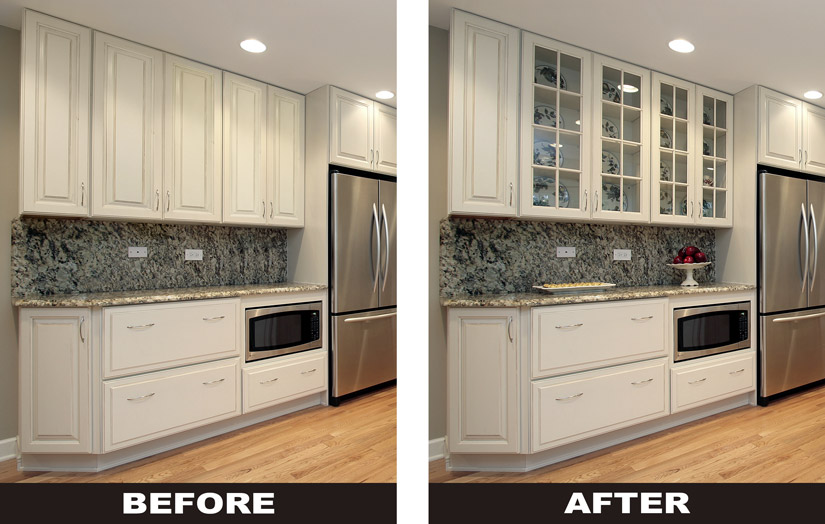
A final matter to consider before making your decision is the style you want for the kitchen. Cabinets are so universally popular that they are at home in kitchens of all styles – modern, transitional, classic, industrial, and so forth. Likewise, wall shelves are such a timeless fixture that they meld harmoniously with any kitchen design, too.
However, if you are trying maintain the historic vibe of a period home, this is another reason to include at least some wall shelves in your design. As Nancy Mitchell points out in her piece on the history of open shelves, people used to outfit their kitchens piece by piece, gradually adding walls shelves, cabinets, and work tables as needed. Including free standing cabinets and open shelves can keep the kitchen in line with the rest of an antique home. For example, check out all the open shelves in the photos of this restored Victorian era kitchen featured in Old House Journal Online.
Finally, a combination of traditional cabinets and open shelving is perfect for those who favor the recent trend away from minimalism. Open shelves give you a place for the layered and eclectic (but thoughtfully curated) displays that make a room more personal. Wall shelves or cabinets with clear glass doors are practically a must-have for kitchens in these styles:
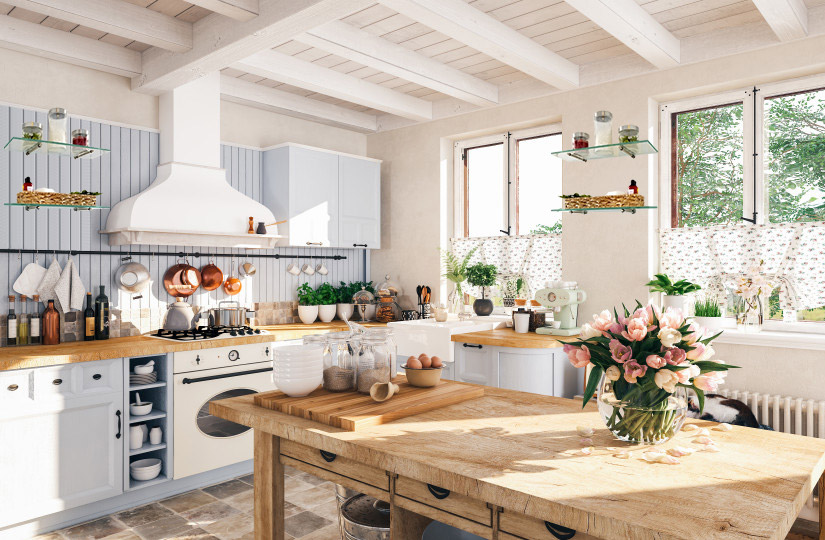
Successfully styling the contents of kitchen wall shelves is all about blending visual appeal and functionality. Jessica Bennett of Better Homes & Gardens breaks the process down into five easy steps. First, “[e]dit down your collection” by choosing only the items you use daily and would like keep handy. Next, find “other items” that will add beauty and charm to the display. Third, arrange “items on shelves according to use” by putting things you use often on the lower surfaces. Fourth, remember to “[v]ary size and scale” by placing large items first, then medium pieces, and finally the smallest objects as finishing touches. Last but not least, include the “under-shelf area” by continuing the display on the surface below the bottom shelf. Check out Jessica’s full article for more details on each step.
More tips for success include:
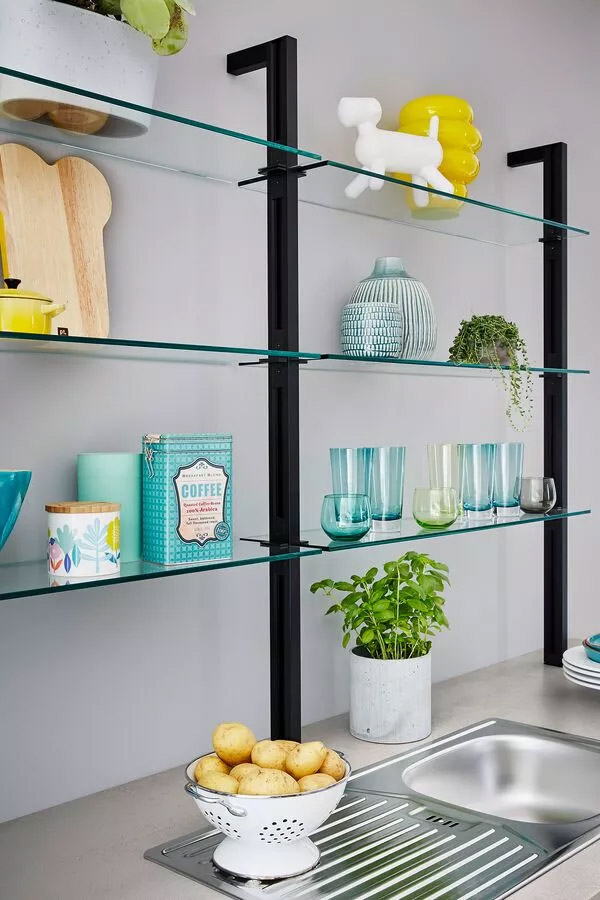
If you prefer cupboards with clear cabinet glass to open shelves, many of the same techniques can be used to showcase your items. There are a few additional points to consider when working with cabinets, though.
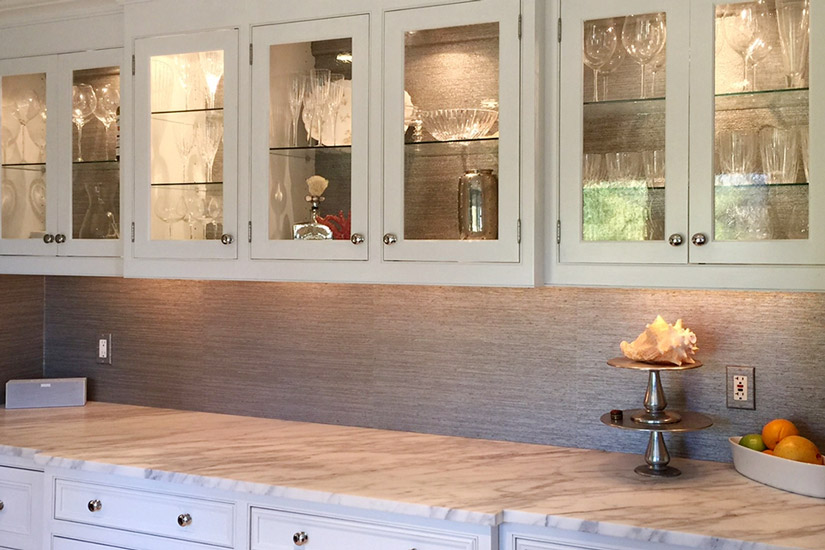
If glass shelves or cabinet glass would help you add beauty, style, and convenience to your kitchen, you may wish to schedule a free in-home consultation with a custom glass expert. ABC Glass & Mirror of Manassas Park, VA specializes in glass installations tailored to the customer’s needs and design goals. We’ll send a glazier to your home to show you samples and pictures, go over product options, take the necessary measurements, and answer any questions you may have. After the consultation, the process follows these general steps:
Call ABC Glass & Mirror at (703)257-7150 to get started!
